
The Pirate Surgeon's Quarters: 1 2 3 4 5 6 7 8 9 10 11 12 Next>>
The Pirate Surgeon's Quarters in the Golden Age of Piracy, Page 3
Pirate Vessels: Frigates
Charles Grey describes frigates as "flush-decked with a round house on the quarter deck of very massive construction, loopholed for musketry,
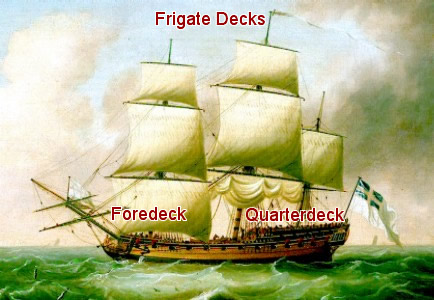
Frigate Decks, Painting by Dominic Serre (18th Century)
and with doors wide enough to permit of a small cannon being placed between the posts to block the entrance and sweep the decks of an enemy, who had gained them."1 Benerson Little describes a frigate in two ways: "A ship with its forecastle and quarterdeck raised above the main deck, and usually with finer lines than most merchantmen" and "A three-masted man-of-war."2 From these two definitions, we get a picture of a frigate's hull. Grey goes on to add detail about a frigate's offensive and defensive capabilities:
Both these places [the forecastle and the quarterdeck] were fronted by heavy scantling [thick wood] pierced for musketry and loopholed for small guns on either side of the sliding door, and in the doors themselves. When the enemy had gained the deck and threatened to overpower the defence, the latter took shelter in the ‘closed quarters’ wherein they could hold out indefinitely, or until the enemy battered or blew in the partitions. Besides the round house and the closed quarters, other means of defence were the fighting tops manned by musketeers, and throwers of grenades or stink bombs.3
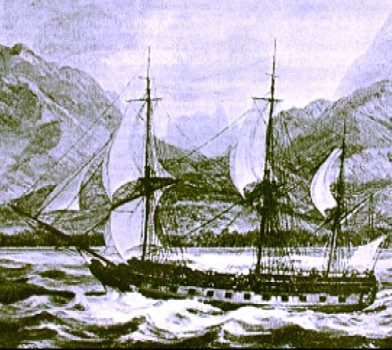
The French Frigate La Boudeuse (c. 1776)
There are three vessels specifically identified as being frigates among the pirate ships in this data. The first is the Bartholomew Roberts fourth and final Royal Fortune, the former Onslow, described as "a fine Frigate built Ship... belonging to the Royal African Company"4. The second is the frigate Morning Star, captained by both John Fenn and George Bradley, resulting in it being counted twice on this list.5 The third frigate is Robert Culliford's Blessed William (which he took from Kidd)6.
These are not the only frigates in the list, although they are the three which have been specifically mentioned as such in this data. The Resolution (called the Mocha before she was taken by pirates) was also originally a frigate built ship. She was captained at different times by pirates Ralph Stout and Robert Culliford. However, she is referred to as a frigate and an East Indiaman in the same passage.7 For this study, she is identified according to her origin as an East Indiaman because it is the more precise and descriptive term. Most of the slave ships were also frigates, but, again, slavers are a more specific category, so they have been included in that category.
Although pirates used frigates, they tended to remove the extraneous decks off to make them flatter, sleeker and faster... and no longer technically frigates. Stout and Culliford's Mocha, Robert's fourth Royal Fortune and Anstis' Morning Star may have started their lives as frigates, but the pirates felt that both would be better suited to their purposes by having their profiles flattened.8 This process, called razeeing a ship, is explored in greater detail in the last section on this page.
1 Charles Grey, Pirates of the Eastern Seas 1618-1723, 1971, p. 39; 2 Benerson Little, The Sea Rover's Practice 2007, p. 233; 3 Grey, p. 40; 4 Daniel Defoe (Captain Charles Johnson), A General History of the Pyrates, Manuel Schonhorn, ed., 1999, p. 228; 5 Defoe (Captain Charles Johnson), p. 295 & New England Courant, 3-11-23 - 3-18, Issue 84; 6 Grey, p. 131; 7 Defoe (Captain Charles Johnson), p. 517; 8 Grey, p. 139 & Defoe (Captain Charles Johnson), p. 229 & 295
Pirate Vessels: Large Craft - Galleys
Galleys were among the earliest types of vessels, predating all historical records.1 Galleys of the type of interest here were quite a bit different than those found in the first thousand
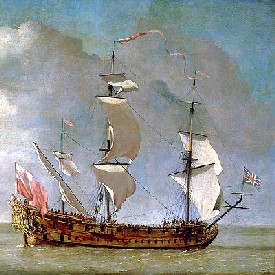
Artist: Willem van de Velde the younger
The Charles Galley. Note the oar ports in the bottom
third of the hull (late 17th c.)
or two years, however. Encyclopedist Ephraim Chambers defines a galley as "a low built Vessel going both with Oars and Sails"2. This simple definition actually contains a lot of information, noting first the design of the hull and second the propulsion of the vessel. Benerson Little gives two definitions for galley, the first being a type of man of war used in the Mediterranean which was not particularly seaworthy and the second being "a ship intended primarily for sail, but which could also be rowed for short distances as required."3
All other things being equal, the pirates would not have wanted an unseaworthy vessel of limited range, nor were they very active in the Mediterranean during the golden age of piracy. So it is the second type of ship which were used by the pirates. Little further delineates the difference by referring to a 'galley-ship' which is "a ship capable of using oars for maneuvering and short transits. Not to be confused with the rowing galley."4 Just to keep things interesting, he also mentions another type of vessel - the galley frigate, which crossed the line between the two basic types of ship hulls.
With regard to the hull, Little explains that a 'galley-built' vessel was "a flush-decked ship, as opposed to one with a raised forecastle and quarterdeck."5 Here we see the clear difference between a ship with a galley hull and one with a frigate hull, a salient point with regard to what the pirates wanted from a vessel. All things being equal, flatter ships were faster than frigates.
Galley oars were sometimes of great use to pirates. When Edward England's pirates attacked James Macrae's East Indiaman Cassandra, Macrae reported that the pirate galley "endeavoured all she could to board us, by rowing with her Oars, being within half a Ship's Length of us above an Hour; but by good Fortune we shot all her Oars to Pieces, which prevented them, and by Consequence saved our lives."6
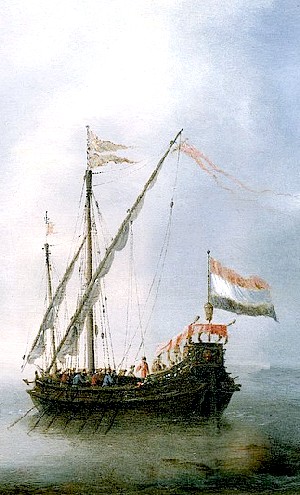
Artist: Jacob Adriaensz Bellevois
A Dutch Galley (Late 17th Century)
Although he escaped that attack, Macrae still lost his ship to the pirates. Francis Spriggs was in the former man of war Batchelor's Delight and Richard Shipton in the sloop Royal Fortune encountered a man of war, putting them "in great Consternation, but however, return'd several Shot at the Man of War, tho' they did not think fit to contest the Honour of the Day, for they got out their Oars with utmost Expedition, and, there being but little Wind, made shift to row into Shoal Water and escape."7 So oars had their uses, both offensively and defensively. Of course, galley oars were not limited to large ships; Thomas Anstis' brigantine Fortune8 and Edward Low in the sloop Fancy9 used them to escape men of war.
In the pirate ship data, there are a number of ships identified as galleys. It is not always clear whether this term refers to the ship having oars was just galley-built or both. Not surprisingly, William Kidd's Adventure Galley is one of these, being specifically built for him in 1695, reported at one point to be "of 200 tons, 30 guns, 26 oars, and 200 of a crew when at Johanna."10 Pirate Sam Bellamy had two galleys, the Sultana12 and the Whydah, a ship reported to be "a very fine London built Galley, of 30 Guns, 200 brisk Men of several Nations"13. However, the Whydah is also described as a slave ship and so is classed as slaver in this data. Edward England's ship Fancy was variously described by witnesses as a man of war14, a Dutch interloper15 and "a fine Dutch-built Galley, which sailed very well, and was a Ship of good Burden."16 She is included here as a galley.
Several other ships are known to be galleys by their names or their former names before the pirates retitled them. These include John James' Alexander, formerly the Providence Galley17, Olivier Lavasseur's Murrune Galley18, Evan Jones' Bedford or Beckford Galley19 and John Smith's George Galley20 which became John Gow's Revenge21.
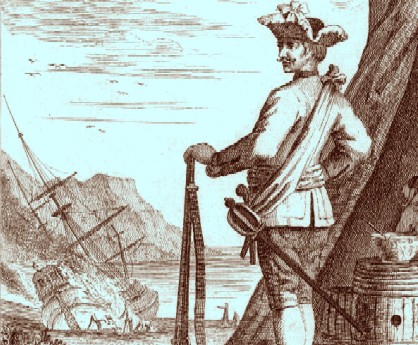
Artist: Joseph Nicholls
George Lowther Overseeing the Careening of His Ship (1736)
Several ships were identified as being both galleys and slavers. Like the Whydaw, the slave ship type was a bit more specific in her design than other galleys, so they are identified in the data as slavers rather than as galleys. For example, William Snelgrave's Bird Galley was captured by a consortium of pirates which were hanging out in an inlet on the coast of Africa. It was taken by pirate Jeremiah Cocklyn, who named it the Speakwell.22 The Gambia Castle, which became George Lowther's ship Delivery, was described as "a fine Galley well provided"11, but was also identified as a slave ship. .
Galleys were probably no friend to the ship's surgeon because oar ports and their seats were located in the lower hull. This would impact the amount of space available in the lower decks, limiting the area where the patients were put while the surgeon operated during a battle. If rowers were required during the battle, you can imagine how difficult it would have been for the surgeon to work, so a galley may not have been the most accommodating addition to a ship for the surgeon.
1 Henry B. Culver, The Book of Old Ships, 1924, p. 1; 2 Ephraim Chambers, Cyclopaedia, Vol. 1, 1728, p. 116; 3,4 Benerson Little, The Sea Rover's Practice 2007, p. 233; 5 Little, p. 239; 6 Daniel Defoe (Captain Charles Johnson), A General History of the Pyrates, Manuel Schonhorn, ed., 1999, p. 119; 7 Defoe (Captain Charles Johnson), p. 355-6; 8 Defoe (Captain Charles Johnson), p. 293-4; 9 Defoe (Captain Charles Johnson), p. 329; 10 Charles Grey, Pirates of the Eastern Seas 1618-1723, 1971, p. 196;12 The Trial of Eight Persons Indited for Piracy &c, 1718, p. 23; 13 The Boston News-Letter, From Monday April 29 to Monday May 6, 1717; 14 John Franklin Jameson, “58. Petition of the East India Company. July, 1696.”, Privateering and Piracy in the Colonial Period – Illustrative Documents, p. 143-4; 15 Clement Downing, A Compendious History of the Indian Wars, 1737, p. 109; 16 Downing, p. 44-5; 17 London Post with Intelligence Foreign and Domestick, 12-1-99 -12-4, Issue 78; 18 Ed Fox, “27. Richard Luntly, from The Last Speech and Dying Words of Richard Luntly (Edinburgh, 1721”, Pirates in Their Own Words, 2014, p. 119-20; 19 Fox, “10. Thomas Bagley, The Examination of Thomas Bagley, 27 August, 1701. HCA 1/53, ff. 96-97”, p. 61 20 Defoe (Captain Charles Johnson), p. 358; 21 London Journal, 3-13-25, Issue CCXCIV; 22 Fox, “73. Captain Davis on the African Coast, From The Weekly Packet, 12 December, 1719. Printed in the Weekly Journal or British Gazetteer, 25 April, 1719", p. 379-80; 11 Defoe (Captain Charles Johnson), p. 304;
Pirate Vessels: Large Craft Battle Oriented Vessels
We now turn to Ephraim Chambers' ship classifications, divided into fighting, fighting/merchant and pure merchant ships. Chambers first two classes include ships intended to fight, with the second being able to be converted to a merchant if desired. The key to a fighting ship was that its design lent itself to weaponry, something the pirates would have found particularly interesting. Although none of the pirate ships found in the data were 'proper' ships of war which would have naval 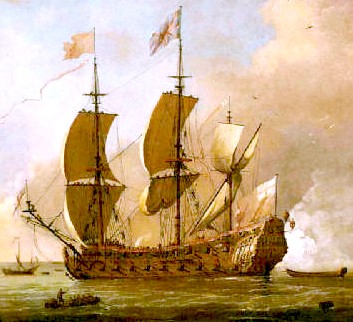
Artist: Adriaen van Diest - A British Fifth Rate Ship (c. 1673 - 1704) ratings, there are several identified as being former men of war. These include Francis Spriggs' ship Batchelor's Delight, which "had been a small Man of War (called the Squirrel), and carry’d 12 Guns; however, they mounted 16 on board her1, the Guelderland, "which had been a Dutch Man of War" and was used by John (Richard) Taylor2 and a third, unnamed ship, described as a "Portuguese Man of War [formerly of 70 Guns]" which Taylor also made into a pirate.3
Interestingly, some of the ships the pirates captured were not men of war when they got them, but were noted have been made into men-of-war. This refers to modifications which pirates made to a vessel to make it more formidable - removing extraneous structures on the deck and removing unnecessary decks to make the ship fast as well as adding more gun ports to make her stronger. Recall that Blackbeard's ship Queen Anne's Revenge was said to have been as well fitted out as as any 5th rate naval vessel. Other examples of pirates modifying ships into men-of-war include Samuel Bellamy and Paulsgrave Williams making "a Man of War of Richards’s [ship Sultana], which they put under the Command of Bellamy"4, James Kelly making a Dutch ship into "a Man of War, mounting 36 Guns in her"5 and an unnamed French ship which Edward Low took, "making a sort of a Man of War of her"6.
Chambers' second class of ships, those which could serve both as war and merchant vessels includes vessels such as privateers and grabs. Privateers could either be smaller, refitted men of war, or upgraded merchant vessels with more ports cut into them for guns. In this way, they were redesigned in much the way the pirates rebuilt merchant vessels. Because the job of a privateering ship was 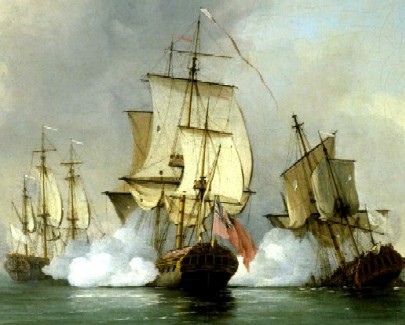
Artist: Charles Brooking - The Privateer Boscowen Engaging French Ships (c. 1750) basically the same as that of a pirate - catching other ships, particularly merchants - they would have been fast and nimble, designed to move and be positioned quickly to overtake prey ships. As such, they made excellent pirates. Note that not all privateers were necessarily three-masted ships, but, lacking other information in this data, they have been classed with the large vessels.
One of the privateer vessels in this data was Bartholomew Roberts' 24 gun vessels Ranger, captained at one point by James Skyrme. She was "a French Ship they had taken [which] sailed well and had formerly been a Privateer of St. Malo"7. (She is counted twice - once for Roberts, once for Skyrm). Other ships mentioned as privateers include Joseph Faro's Portsmouth Adventure and Richard Want's Dolphin8, Walter Kennedy's 30 gun Royal Rover which which he stole from Roberts9 (also counted twice under Captains Roberts and Kennedy) and Edward/Christopher Condent's Flying Dragon, "a Dutch Ship, which had formerly been a Privateer"10. Although they are not part of the large ship data, two sloops are referred to as privateers. The first is mentioned in conjunction with Edward Teach who, after taking the Concorde and turning her into the Queen Anne's Revenge noted that their "Sloop the Revenge... was now called their Privateer"11 presumably because she would be their fast, well-gunned chase ship. The second appears in forced man Philip Ashton's account of his time spent among Edward Low's pirates. Ashton explains that Low took an unnamed Rhode Island built sloop of 70 tons and 4 guns "and he made a Privateer of her."12 However, being sloops, neither is counted here as a large vessel.
The last war-like ship is the grab. John Henry Grose described grabs in a book about his voyage to 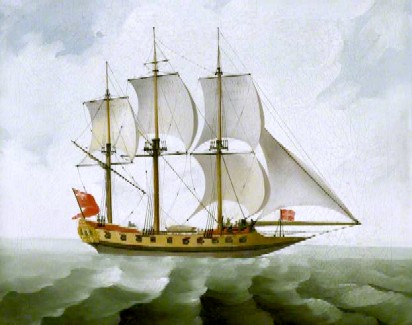
A Bombay Grab (c. 1780) the East Indies in 1750 as vessels being of the same burden as English galleys holding 18-20 guns, "built in the country... with prow, which seem best calculated for carrying chace-guns. The scheme of those people's [the Maratha people of India] gunnery being chiefly to get into the wake of their enemy, and rake him fore and aft"13. Grose also notes that grabs "are too slightly built to lay along-side of any ship of the least weight of metal. Their great stress lies on those prow-guns, which they manage to special advantage in a calm, having armed boats to tow them a-stern of the vessel they attack"14. Grabs are elsewhere said to be "of two classes, two masters up to 150 tons and three masters about 300 tons... They are broad in proportion to their length and draw little water. They narrow from the middle forward where instead of bows they have the prow of a Mediterranean galley covered with a strong deck level with the main deck"15. The only grab found in the pirate ship data is the 200 ton Alexander (II), captained by William Read.16 When Read died, John James became the captain, but he "fitted up the Grab, and made a Ship of her"17.
1 Captain Richard Hawkins, The British Journal, 8/8/1724 & Daniel Defoe (Captain Charles Johnson), A General History of the Pyrates, Manuel Schonhorn, ed., 1999, p. 336; 2 Ed Fox, “44. Richard Moor, from The Examination of Richard Moor, 31 October, 1724. HCA 1/55, ff. 94-97”, Pirates in Their Own Words, 2014, p. 210; 3 Defoe (Captain Charles Johnson), p. 312; 4 Fox, “21. The Whydah survivors tell their stories, Printed as appendix of The Trials of Eight Persons Indited for Piracy (Boston, 1718), pp. 23-25”,p. 85; 5 Fox, “7. James Kelly on two decades at sea. (London, 1700)”,p. 49; 7 Defoe (Captain Charles Johnson), p. 334; 8 Pyrates Lately taken by Captain OGLE", 1723, p. iv-v; 8 John Franklin Jameson, “63. Examination of John Dann. August 3, 1696.”, Privateering and Piracy in the Colonial Period – Illustrative Documents, p. 153; 9 Defoe (Captain Charles Johnson), p. 206; 10 Defoe (Captain Charles Johnson), p. 582; 11 The Tryals of Major Stede Bonnet, 1719, p. iii; 12 Philip Ashton, Ashton’s Memorial of Strange Adventures and Signal Deliverance, 1726, p. 32; John Henry Grose, A voyage to the East Indies, 1772, p. 42; 15 Bombay Government Press, Gazetteer of the Bombay Presidency, vol. .26-2, 1893, p. .523-4; 16 Defoe (Captain Charles Johnson), p.473-4; 17 Defoe (Captain Charles Johnson), p.474
Pirate Vessels: Large Craft Merchant Vessels
This brings us to Ephraim Chambers' third class of ships: merchants. In the golden age pirate ship data there are two types of ships which belong in this class: East Indiamen and Slavers. 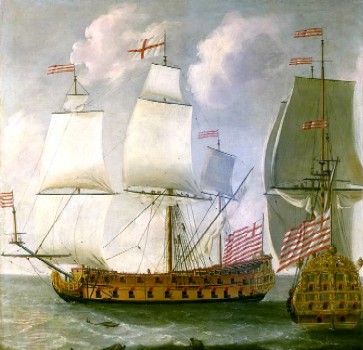
Artist: Isaac Sailmaker
Side and Rear View of an English East Indiaman, From the Time of William III
The first merchant ship in this list was specific to the East Indies - the (aptly-named) East Indiamen. Slavers, on the other hand, typically started their slaving journey from the west coast of Africa, although there were some which made their way around the continent to Madagascar and the west coast of Africa.
The East Indiaman was one of the largest types of merchant ship being "well armed and heavily manned. Pirates both of eastern and western provenance were always to be feared, while the numerous wars in which England participated during the term of the Company's existence rendered it necessary to be well prepared for emergency."1 Naval historian Stephen Howarth notes that East India Company ships "at a distance could easily be mistaken for first-rate warships."2 The East Indiamen "were many times larger than the craft employed in all other trades."3 The book Heyday of Sail bears this out, explaining that in 1681, "the East India Company owned and estimated thirty-five vessels, whose size varied between 100 and 775 tons, whilst between 1682 and 1689 sixteen East Indiamen were built and their sizes varied from 900 tons to 1300 tons."4
They were like warships in more than just size, though. "On the levels of the upper deck and upper gun-deck, the similarity to warships continued internally. Below the lower gun-deck the internal similarity to a warship 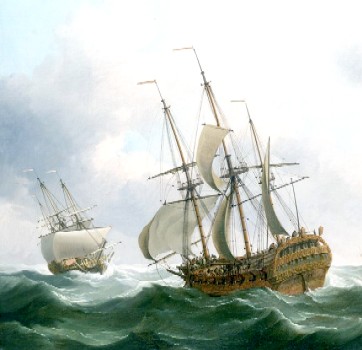
Artist: Charles Brooking
East Indiamen in a Gale (mid 18th century)
ceased abruptly: the whole of the rest of the interiour space, amounting to half the height of the hull from keep to upper deck, was the enormous hold. This was, after all, a merchant ship."5 Still, because of their size and guns, they were "powerful enough to make most predators think twice."6
Still, a few pirate predators did manage to capture East India ships, although they were probably not all East India Company East Indiamen. The previously mentioned 500 ton Cassandra, captained at different times by Edward England, Jaspar Seagar and John (Richard) Taylor was specifically mentioned upon its capture in the Daily Post as an "East-India Man... and was taken by 4 Pyrate Ships at Johanna in the East-Indies."7 Thomas Howard took "an India Ship called the Prosperous" at New Mathelage [modern Mahajanga] on Madagascar which they manned with 36 guns.8 Captain Edward Fenwick of the East Indiaman Pembroke said that she was reported to have been "formerly a permission ship on a trading voyage"9. The ship Resolution, commanded by both Ralph Stout and Robert Culliford (and so counted twice) was the renamed "East India Company's ship Mocha (Captain Leonard Edgcumbe)"10. So, even though there are six East Indiamen in the data, they were, in reality, three ships under six different captains.
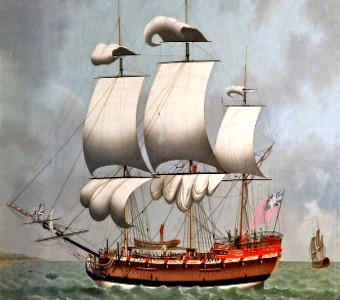
Artist: William Jackson - A Liverpool Slave Ship, (18th-19th c)
The other type of merchant vessel found in the pirate ship data is the slaver which, as it's name suggests, was used to transport slaves from Africa, particularly to the West Indies. During the golden age of piracy, slave ships were also called Guineamen, in reference to their trading on the Guinea (African) coast.
The slave trade began in the 16th century with regular merchant ships being adapted to the task of transporting the slaves. The English Royal African Company, created in 1660 and active throughout the golden age of piracy in slave trading, began by hiring other merchant ships to carry the slaves, eventually turning to outfitting their own vessels. Another form of slave ship, those not licensed by the Company, also gathered slaves from Africa, being referred to as interlopers. Because so many different vessels were used in slaving, their sizes varied. The slavers found in the pirate data ranged in burden from 200 to 500 tons.
As the trade became more established, slavers built purpose-designed ships for their trade like the English Royal African Company. Such ships "included portholes for better airflow to the lower decks and copper-sheathed hulls to combat the wood rot and boring worms found in tropical waters. Sometimes ships were modified to increase the space between decks, although a typical 140-ton Guineaman might have had only four and a half feet between the lower deck's floor and ceiling."11
Typically galleys, slave ships had quarterdecks, allowing the crew to oversee the main deck. The purpose-built Guineamen 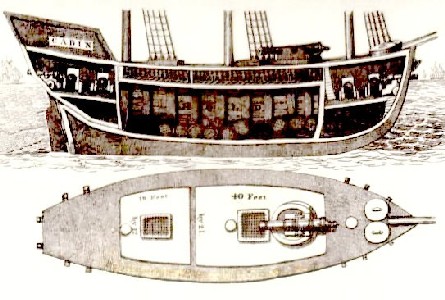
Cross-Section of a Slaver, Notices of Brazil in 1828 and 1829,
by Robert Walsh (1831)
also had "a ten-foot-tall wooden barricade that bisected the deck at the main mast and extended about two feet beyond the ship's sides" on the main deck.12 This allowed the crew a place of safety if the slaves revolted. (It would also have been removed by the pirates if they decided to make a slaver their ship.)
Like several other ships of interest to the pirates, slave ships were designed to carry a fair amount of weaponry. "Slave ships were well armed in case of insurrection or attack by pirates. According to an officer on the 140-ton Diligent, which sailed out of France in 1731, the ship carried 'eight four-pound cannons, fifty-five muskets, eighteen pistols, twenty swords, and two swivel guns, all in excellent condition.'"13 They were also fast, with Angus Konstam stating that "[s]lavers made good pirates ships, as they were built for speed."14 This was probably due at least in part to the mortality rate found among the slaves; the faster a Guineaman could get to its market, the lower this number was likely to be.
There are several slave ships found in the ship data. As mentioned in the section on galleys, the slave ship Bird, belonging to William Snelgrave15, was captured on the coast of Africa and made into the pirate ship Speedwell or Speakwell by Jeremiah Cocklyn.16 She was also captained by John (Richard) Taylor, giving her two spots on the list.17
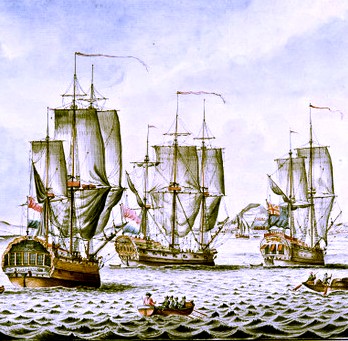
Artist: S. Weuijster - Slave Ships Off St. Eustatius (1763)
The Bumper Galley taken by mutiny and eventually captained by George Lowther who renamed her Happy Delivery. She was described in a newspaper report as being "in the African Company’s Service, the Seamen being joined by some Soldiers, put the Master ashore on the Coast of Guinea, and turned Pirates."18 Samuel Bellamy's pirates were cruising "near Long Island (Bahamas) where in February 1717 they intercepted the Whydah, a large Bristol slaver…of 155 men" which they took and made a pirate.19 On his way to the East Indies in the Condrade, Olivier Levasseur "met with an English Merchant ship called the Indian Queen laden with slaves which he took and afterwards went onboard the same with all his crew"20. John Bowen's ship Speaker was originally a man of war which had been "taken by the English... bought by some London Merchants, and fitted out from that Port, to slave at Madagascar, and go to Jamaica."21 Probably the most famous slaver was Blackbeard's ship. Edward Teach "took the 300-ton French slaver Concorde as it was approaching Martinique on November 28, 1717, diverting this big prize to the island of Bequia in the Grenadines so as to convert it into his own flagship", which he famously renamed Queen Anne's Revenge.22
Not all slavers were three-masted ships. When John Welch's pirates mutinied in 1703, they took possession of a 200 ton brigantine which "was commissioned for a cruise of the Guinea Coast."23 She is not included in the large ship data, instead appearing in the small ship data on the next page in the brigantine class of small vessels.
1 Henry B. Culver, The Book of Old Ships, 1924, p. 157; 2 Stephen Howarth, Historic Ships: The Glory of the Sailing Ship from the 13th to the 19th Centuries, 2000, Plate 184 (not paginated); 3 The Heyday of Sail: The Merchant Sailing Ship 1650 - 1830, Robert Gardiner, ed., 1992, p. 24; 4 The Heyday of Sail, p. 25; 5,6 Howarth, Plate 184 (not paginated); 7 Daily Post, 4-18-21, Issue 483; 8 Daniel Defoe (Captain Charles Johnson), A General History of the Pyrates, Manuel Schonhorn, ed., 1999, p. 459-60; 9 Charles Grey, Pirates of the Eastern Seas 1618-1723, 1971, p. 236; 10 S. Charles Hill, “Three Accounts of the Fight Between the Dorrill and the Mocha, 1697”, The Indian Antiquary, S. Charles Hill, ed., Volume XLIX, January, 1920, p. 1; 11,12,13 Brendan Wolfe, "Slave Ships and the MIddle Passage", Encyclopedia Virginia website, gathered 12/26/18; 14 Angus Konstam, The Pirate Ship 1660 -1730, p. 24; 15 See Captain William Snelgrave, A New Account of Some Parts of Guinea and the Slave Trade, 1734, p. 272; 16 Ed Fox, “73. Captain Davis on the African Coast, From The Weekly Packet, 12 December, 1719. Printed in the Weekly Journal or British Gazetteer, 25 April, 1719", Pirates in Their Own Words, 2014, p. 379-80; 17 Fox, "41. John Matthews, from The Examination of John Matthews, 12 October, 1722. HCA 1/55, ff. 20-21", p. 193; 18 Fox, “74. Lists of ships taken by pirates", p. 383-4; 19 Joel Baer, British Piracy in the Golden Age, Vol. 2, 2007, p. 289; 20 Fox, “41. John Matthews, from The Examination of John Matthews, 12 October, 1722. HCA 1/55, ff. 20-21”, p. 294; 21 Defoe (Captain Charles Johnson), p. 476; 22David Marley, Pirates of the Americas, Vol. 2, 2010, p. 529; 23 Charles Grey, Pirates of the Eastern Seas 1618-1723, 1971, p. 259
Pirate Vessels: Modifications and Their Effects
"...[George Lowther's pirates] had a good Ship under them, a parcel of brave Fellows in her, that it was not their Business to starve, or he made Slaves; and therefore, if they were all of his Mind, they should seek their Fortunes upon the Seas, as other Adventurers had done before them. They one and all came into the Measures, knocked down the Cabins, made the Ship flush fore and aft, prepared black Colours, new named her, the Delivery, having about 50 Hands and 16 Guns..." (Daniel Defoe (Captain Charles Johnson), A General History of the Pyrates, Manuel Schonhorn, ed., 1999, p. 307)
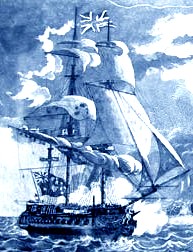
Artist: John Fairburn
Razee HMS Indefatigable - Note
the
Flat Profile of the Decks (1796) Modifying a vessel to suit the pirates' needs was such an important part of their work and it deserves a section unto itself. Some of these modifications were simple: John James's pirates added a third mast to their grab to make into a ship.1
Others were more involved. Charles Johnson gives us a detailed account of pirates razeeing a ship when Bartholomew Robert's pirates caught the Royal Africa Company's slave frigate Onslow. Finding her to be well-suited for pirating, they "fell to making such Alterations as might fit her for a Sea-Rover, pulling down her Bulk-Heads, and making her flush, so that she became, in all Respects, as compleat a Ship for their Purpose, as any they could have found; they... [gave her] the Name of the Royal Fortune, and mounted her with 40 Guns."2 In reference to the Ralph Stout and, later, Robert Culliford's Mocha, captured ship captain William Dorrel explained that when he saw her, the pirates "had taken down all her galleries [structures sort of like balconies on a ship]"3. John Martel's pirates told Captain Wilson of the John and Martha that his "Ship would answer his Purpose exactly, by taking one Deck down… Having fitted up the aforesaid Ship, as they design’d, they mounted her with 22 Guns, and 100 Men... and so proceeded to cruise off the Leeward Islands"4. Thomas Anstis' men also captured a frigate, the Morning Star, which they planned "to fit up and clean... and put her in a Condition to do Business"5. Henry Every's ship Charles II was improved by "having taken down a great deal of his upper work and made her exceeding snugg, which advantage being added to her well sailing before, causes her to sail so hard now that shee fears not who follows her."6 After capturing a Portuguese ship, Thomas Howard tore "off her upper Deck, made her deep wasted, and much snugger, by cutting down some of her Gunnel. This Prize they named the Alexander."7
Many of the modifications pirates made to the upper decks of the ship had to do with flattening their profile by clearing the decks. David Cordingly explains "'making her flush' suggests that the pirates also removed the forecastle and lowered the quarterdeck. A flush-decked ship was one without a break or step... [providing] the pirates with an unobstructed fighting platform."8 While these changes made the vessels better suited to the pirate's needs, they wouldn't have had a lot of impact on the ship's surgeon.
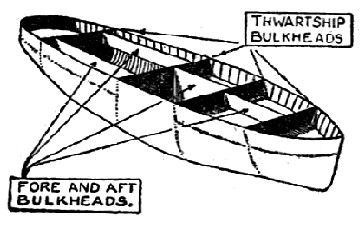
The Bulkheads on a Ship, from The Seaman's Pocket-book (1943)
While Roberts was reworking the Onslow, it says that he pulled 'down her Bulk-Heads'. Cordingly explains that "the pirates removed the bulkheads, or internal walls below decks, which were installed to hold the cargo. This created a clear space for working the guns, as in a man-of-war."9 In addition, because the lower decks of many merchant vessels would not have gun ports through the side of the ship, the pirates' carpenters made them by piercing the hull.10 Merchant ships rarely mounted guns anywhere but the upper decks since their purpose wasn't to engage in battle. Since pirates wanted as much ordnance as they could reasonably fit on the ship, they modified it for that purpose. "By piercing the hull for additional ports, the pirates converted the vessel into a warship."11 When Edward Low "took a large Ship, called the Merry Christmas... [he] fitted her for a Pyrate, cut several Ports in her, and mounted her with 34 Guns."12
Much of this work affected the surgeon's normal working area. On the plus side, if there were bulkheads in the area where the surgeon normally practiced, it would have given him more room to put incoming patients. On the minus, if the pirates installed cannon there, it would have made the surgeon's work environment cramped, noisy, hot and miserable.
1 Daniel Defoe (Captain Charles Johnson), A General History of the Pyrates, Manuel Schonhorn, ed., 1999,, p.474; 2 Defoe (Captain Charles Johnson), p. 229; 3 Charles Grey, Pirates of the Eastern Seas 1618-1723, 1971, p. 139; 4 Defoe (Captain Charles Johnson), p. 295; 5 Defoe (Captain Charles Johnson), p. 64; 6 John Franklin Jameson, “59. Extract, E.I. Co. Letter from Bombay. May 28, 1695”, Privateering and Piracy in the Colonial Period – Illustrative Documents, p. 145; 7 Defoe (Captain Charles Johnson), p. 64; 8 David Cordingly, Under the Black Flag, p. 159-60; 9 Cordingly, p. 159; 10,11 Angus Konstam, The Pirate Ship 1660 -1730, p. 14; 12 Defoe (Captain Charles Johnson), p. 335

